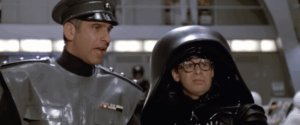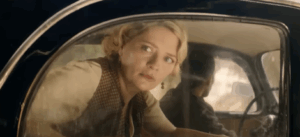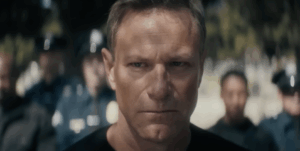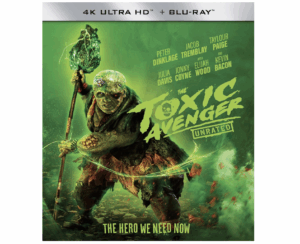THE FILM
Is We Live in Time the romance for the ages, or a more intricate emotional puzzle from A24? Directed by John Crowley (The Goldfinch) and written by Nick Payne, this tear-inducing drama plunges deep into the complexities of love, loss, and time, with Andrew Garfield and Florence Pugh leading the way in a narrative told with an unconventional structure. From the outset, the audience knows that the romance between Tobias (Garfield) and Almut (Pugh) is doomed, a knowledge that, while seemingly tragic, adds a layer of poignancy to a love story that feels, in many ways, natural and inevitable.
At its heart, the film is about the fragility of relationships and the profound ways in which they are shaped by time. It explores the life of a couple who, despite their best efforts, find themselves caught in the currents of fate, love, and mortality. But in some ways, We Live in Time doesn’t simply fall into the well-worn narrative of doomed romance that we’ve come to expect, something akin to Love Story or even The Fault in Our Stars, but instead veers into a more nuanced territory, one where time itself feels like an entity in constant flux. If anything, We Live in Time shares some thematic similarities with Sam Mendes’ American Beauty, where beneath the façade of suburban tranquility lies an undercurrent of unease, making clear that no relationship is as simple as it seems at first glance.
In the same vein, Crowley’s film, with its non-linear structure, presents a couple’s romance and eventual decay through a fragmented lens. It’s here that We Live in Time starts to resemble Robert Zemeckis’ Here, a film that played with disjointed timelines to similarly chart a relationship’s growth and collapse. Yet Crowley’s approach goes deeper into the emotional intricacies of this couple’s bond, using the motif of food and cooking; central to Almut’s character as a professional chef, as a metaphor for the careful preparation and inevitable breakdown of love. There is a rawness in watching these two characters, whose lives are so intimately tied to the rhythms of life and death, attempt to stitch together a future they know is slipping away.
The jumbled structure of the film, at first, might seem like nothing more than a gimmick, but it ultimately provides a more visceral experience. By presenting Tobias and Almut’s journey out of order, Crowley and Payne engage with an almost self-aware foreknowledge of the tragic end that awaits them. The film’s non-linear style becomes a paradox: while the end is known, the emotional journey through time feels unpredictable and gut-wrenching. The early moments, when Almut’s car accident delivers a jarring but oddly charming date; might give one the impression that this is a romance with all the clichés in place. But what follows, with its fractured timelines and fleeting moments of connection, brings an intensity and emotional weight that only grows as the film progresses.
Though We Live in Time never falls into the trappings of melodrama, there’s no denying its emotional potency. Garfield and Pugh bring such sensitivity to their roles that their performances are nothing short of extraordinary. Garfield, with his trademark expressiveness, portrays Tobias as a man both torn by grief and searching for meaning in a relationship that’s constantly evolving and deteriorating. Meanwhile, Pugh imbues Almut with a quiet strength and a haunting vulnerability that deepens the emotional resonance of her character. It’s their chemistry, built on these small, unspoken moments, that drives the narrative forward, despite the disjointed storytelling.
As the couple’s journey unfolds, the film touches on themes of identity, love, loss, and the passage of time; all while using a rather limited set of locales to explore the depth of their experiences. These include the aforementioned car accident, moments of courtship that verge on awkwardness, cohabitation, repeated cancer diagnoses, and the birth of a child in one of the film’s most strikingly offbeat sequences. The birth scene, in particular, emerges as the film’s unexpected action sequence, a comment Garfield himself humorously notes in the making-of commentary, highlighting the film’s balance of humor and devastation.
In discussing the film’s peculiar structure, Crowley and Payne reveal just how much trial and error went into shaping We Live in Time. The editing process, as detailed in the making-of commentary, involved various experiments with montage theory; some of which echo the meticulous planning of Syd Field’s famous screenplay structure. There’s something almost academic in their approach, but the result is a film that feels deeply personal and urgent, yet disarmingly fragile. The fractured structure, in this sense, isn’t a device to confuse but to heighten the emotional complexity of the story.
What strikes the viewer most, however, is the film’s ability to create a sense of impending doom without slowing down the narrative. Unlike Love Story, where there is time to linger on the protagonist’s inevitable death, here the emotional impact is immediate, unspooling quickly but with devastating effect. It’s an audacious storytelling choice, one that at times feels overwhelming, but ultimately serves to deepen the film’s emotional punch. There’s little room to catch one’s breath in We Live in Time, but that’s part of the brilliance, by denying the audience the luxury of time, Crowley forces us to confront the truth of these characters’ fleeting moments of joy and pain.
In the end, We Live in Time may be a romance, but it is also a meditation on time itself; the fleetingness of moments, the inevitability of loss, and the ways in which we struggle to preserve love in the face of it all. Though it borrows heavily from familiar cinematic tropes, it remains an audacious and heartbreaking exploration of what it means to love and to lose. Whether you view it as a clever structural experiment or an unrelenting emotional exercise, We Live in Time is undeniably powerful in its exploration of love’s inevitable decay. And though the foreknowledge of its tragic ending may give us pause, it’s a film that is, perhaps, precisely what we need in an era that demands both emotional release and intellectual rigor.
BUY WE LIVE IN TIME FROM A24 HERE
THE VIDEO
We Live in Time, presented on Blu-ray courtesy of A24, arrives with an AVC-encoded 1080p transfer in a cinematic 2.39:1 aspect ratio. The technical details, this transfer is an impressive one, offering a presentation that showcases the film’s striking visual composition in all its emotional and aesthetic complexity. The image is sharp and clear, with an exceptional level of fine detail that enriches the film’s exploration of love, decay, and memory. The clarity is consistently excellent, maintaining a crispness that ensures textures and subtleties, particularly in close-ups, are always vividly rendered. But it’s not just the sharpness that impresses; it’s also the way the transfer handles the film’s varied and often striking color palette. The grading choices are particularly noteworthy, providing an extra layer of emotional resonance to the material.
The film’s color palette spans a range of tones, each supporting the mood and rhythm of the narrative. There are cool, muted blue tones, especially in the opening scenes where Almut is out on a jog, an early visual cue that signals the impending emotional chill to come. These blues give the image a crisp, almost clinical look, which contrasts with the warmer, buttery yellows that emerge during the more romantic moments between Almut and Tobias. These yellow hues, soft yet inviting, add an intimate warmth to the otherwise fleeting connection between the two characters. What is particularly commendable is the transfer’s ability to retain fine detail and clarity across such a broad range of hues. Whether bathed in cooler tones or enveloped in warm light, the image remains sharp and detailed, a testament to the strength of the Blu-ray presentation.
The presentation is flawless in its technical execution, with no noticeable compression artifacts to detract from the visual experience. Given the emotional weight carried by the film’s imagery, it’s a relief to see that A24’s Blu-ray release preserves the integrity of the visuals. In all, We Live in Time on Blu-ray is a pristine visual experience, expertly capturing the emotional and aesthetic depth of a film that is as much about the way time shapes relationships as it is about how we remember them. For those who appreciate the technical artistry of modern cinema, this is a transfer worth savoring.
THE AUDIO
It’s perhaps a bit unexpected that We Live in Time, a film deeply rooted in intimate moments and the slow unraveling of love, features a Dolby Atmos track. Given the subdued, introspective nature of the material, one might assume that the sound design would lean towards a more traditional, minimalist approach. However, in this case, the Dolby Atmos soundtrack proves to be surprisingly effective, if not the showiest of its kind. What makes this sound mix stand out is its ability to create a nuanced sense of space. Even in the more cloistered, close-knit environments of Tobias and Almut’s shared moments, whether in their kitchen or during quieter, personal exchanges; the track establishes clear spatial relationships, subtly guiding the listener through the physical and emotional closeness of the characters. The sense of proximity is tangible, lending a feeling of intimacy that mirrors the film’s themes of fleeting connection and inevitable loss.
The score, composed by Bryce Dessner, is another key player in this atmosphere. The music is often woven through the side and rear channels, subtly enveloping the viewer in its haunting, sometimes dissonant, textures. The cues, often more understated, yet emotionally resonant; reinforce the film’s quiet, contemplative mood, while still managing to engage the full range of the surround channels. While Dessner’s score may not dominate the film’s soundscape, its presence is both elegant and essential, grounding the narrative’s deeper emotional beats. Dialogue is handled with clarity and precision throughout, ensuring that the intimate exchanges between Garfield and Pugh remain the focal point, free from any interference from the sound design. The lines come through cleanly, unobstructed by the environmental or musical layers, which is crucial to maintaining the film’s delicate emotional balance.
While We Live in Time‘s Dolby Atmos track may not be the loudest or most extravagant like a Mad Max movie, it serves the film’s intimate narrative with precision and care. It enhances the emotional depth of the story, subtly drawing us into the world of Tobias and Almut, allowing us to feel both their closeness and the space between them, all while never overshadowing the quiet intensity of their love. It’s a sound design that knows when to be present and when to recede; much like the film itself.
THE EXTRAS
There is only one extra on this release of cast and crew interviews plus a commentary track that gives away major spoilers of the film in its first couple of minutes. Proceed with caution if you haven’t watched the movie yet.
- Audio Commentary – Director John Crowley and Wirter Nick Payne
- A Whole Life: The Making of We Live In Time (10 Mins.)
- Art Cards
THE ULTIMATE WORD
We Live in Time is a bittersweet romantic drama that offers up some emotional moments but is ultimately stymied by the predictability of its story. It’s a film that leans heavily on the star power and chemistry of Pugh and Garfield, but despite its best efforts to play with narrative structure, it remains, at heart, a very traditional tearjerker. A little innovation can only go so far when the story is already so entrenched in familiar heartache. The 1080p HD image looks divine while the surprising Dolby Atmos audio track sounds nuanced and big. There’s not too many extras here, however, there is a great audio commentary track with spoilers. Recommended.









